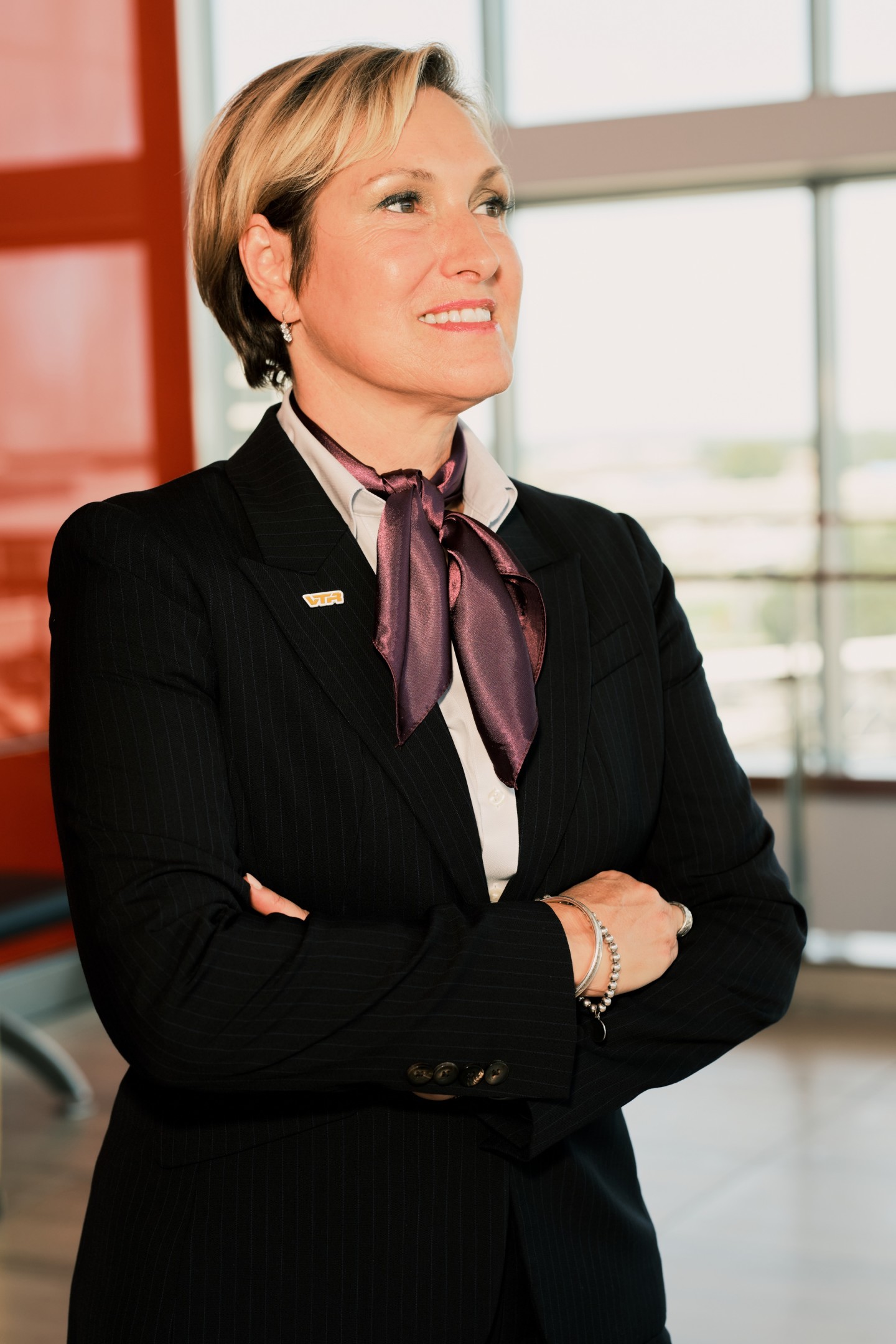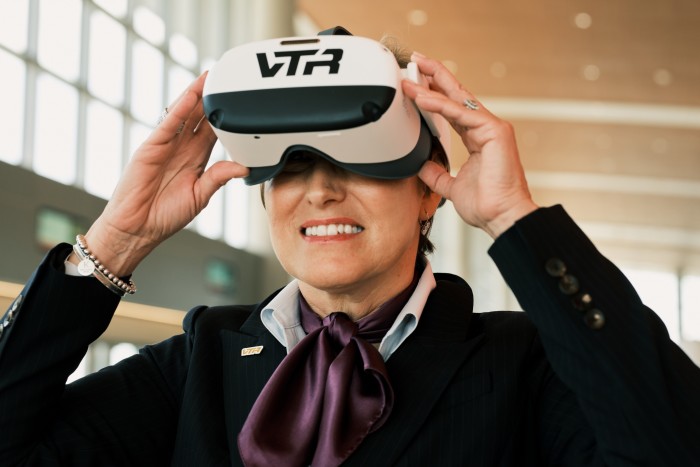Pilot project: airline captain turns entrepreneur

Roula Khalaf, Editor of the FT, selects her favourite stories in this weekly newsletter.
In 2016 — just as she entered recovery following treatment for an aggressive form of breast cancer — Evey Cormican started an executive MBA. It was something she decided to do as soon as she received her diagnosis, which left her unable to work as an airline pilot.
“When I started flying, it didn’t really dawn on me that I wouldn’t be able to fly or that I would get grounded at some point,” she says. “And, when I did, the first thing I thought was, ‘I’m going back to school to get my MBA’, because I’ve always wanted to.”
The EMBA programme helped keep her spirits up, even if her wings were clipped. “It was a rough, rough time,” she says. “And thank goodness I had this to boost my confidence. It’s such an amazing way to keep your brain moving and keep yourself from going to dark places.”
Education is woven throughout her career, which has taken her from airline pilot to teaching her peers, and now to founding a virtual reality pilot training start-up.
In eighth grade in suburban Chicago, her journalism teacher set an assignment to interview someone in a job Cormican felt she could not herself pursue. She lived close to an airport and thought, “Oh, that’s easy. I’ll go interview a pilot because everybody knows only military men become pilots.”
When she arrived to interview the chief pilot at the nearby flight school, she had 10 questions. But, as they talked, those questions multiplied and Cormican ended up going for a flight. “That is how I was bitten by the aviation bug,” she says.
She started learning how to fly aged 16, before completing her training at the University of North Dakota. In 1997, she secured a job flying for what was then Continental Airlines.
Training and teaching became a large part of her work. In the early 1990s, for example, Cormican was the chief pilot and flight instructor of Altitudes Flight Training. She also held a variety of educational roles at Continental, and — after a 2010 merger — at United Airlines. These included human factors training, which aims to understand the connection between employees, their equipment and the surrounding environment; as an instructor for “check airmen”, who assess other pilots; and as vice-chair of the Air Line Pilots Association’s training committee.
“I found my passion for teaching and learning just followed me through,” she says. “ . . . I loved the flying part, but I was also intrinsically satisfied by doing other things in the career and in the field.”
During an entrepreneurial class at Kellogg School of Management at Northwestern University in Illinois, Cormican — who jokes “I couldn’t spell IT before the EMBA” — worked in a team with tech experts. She found herself learning more about technology and, as she did, her passion for aviation combined with this new knowledge. “We would talk about aviation, and talk about simulation and talk about how pilots are trained and things like that. And virtual reality and augmented reality came up, and once I got exposed to it, I said, ‘Oh, this is unstoppable’.”

With that, the seeds of a business were planted. But it took a second leave of absence due to complications from her treatment for Cormican to get started.
In 2017, during a leave of absence, she established Visionary Training Resources, a start-up that provides virtual reality airline pilot training. “I’m viewing it as a little bit of an act two,” says Cormican, noting that VTR brings together her passion for learning, her EMBA — and the confidence it gave her in the business world — and her aviation knowledge.
There is a significant shortage of pilots — Cormican says the industry needs 450,000 airline pilots in the next 20 years — and the aim is to use VR to “produce better pilots, faster” while maintaining safety. The company is also looking at other ways VR can be used in the aviation industry, including in soft skills development, onboarding, interviewing and staff training.
The EMBA has been instrumental in helping to get the business off the ground. Cormican says some of her senior executives at VTR — which currently employs 38 people — are from the Kellogg network, as are many of her investors and advisers whose expertise in their respective fields has been valuable.
“One of the professors, Professor Harry Kraemer, teaches leadership classes, typically. And he likes to say: ‘Who is on your bus? If you’re going to start something, you need to fill up your bus first’,” she recalls. “I had a really big bus.”
Professor Leigh Thompson’s class on leading high-impact teams was also powerful. “When I went to Kellogg, I was already a captain,” recalls Cormican. “So my teams typically consisted of between five and 12 people, depending on the size of the airplane I flew,” she says.
“I thought I knew how to lead a high-impact team — only I didn’t,” she says, noting that the key is knowing the difference between “bootstrapping” and understanding the structure behind what happens in high-performing teams.
CV
1997-present United Airlines. Roles include Captain B757/B767, captain and assistant chief pilot at Houston Texas and a simulator instructor check pilot
2017-present Founder and chief executive (CEO) of Visionary Training Resources Inc
2009-2011 Consultant at Hughes Aerospace Corporation
1995-1997 Captain and first officer at Frontier Airlines
1995 First officer at United Express
1994-1995 First officer at Continental Express
1990-1994 Altitudes Flight Training. Roles included chief pilot and flight instructor, charter pilot and corporate pilot
This has affected how she approaches leading VTR. At first, when it was just her running the business, she was across everything. But, as the start-up has grown, she tries to remain “stepped back”. This helps her keep a wider perspective, but also allows her team — “who are high functioning, who know their work much better than I ever could” — to get on.
When it comes to leading a high-impact team, she says, you do not actually do it yourself. “They’re leading it. You are there to help them.”
After the EMBA, Cormican found the alumni network would soon be a little closer to home: as soon as she finished, her husband, also an airline pilot, started the course. Indeed, her advice to anyone thinking about studying the EMBA is: “just do it.”
“There’s never going to be a perfect time, or a perfect reason or a perfect job”, she says. “The next two years, they will go by one way or another. If you start it, you will finish and you will come through the other end in a transformed, better version of yourself.”

Comments